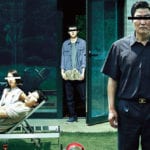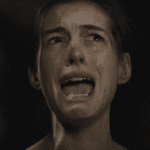 Creepy
Creepy  Creepy
Creepy  Movies and TV
Movies and TV 10 Movies That Get Elite Jobs Right, According to Experts
 Weird Stuff
Weird Stuff 10 Times Real Laws Were Based on Bizarre Hypotheticals
 Animals
Animals 10 Inspiring Tales of Horses Being Human
 Mysteries
Mysteries Top 10 Haunting Facts About the Ghost Ship MV Alta
 History
History 10 Surprising Stories About the Texas Rangers
 Humans
Humans 10 Philosophers Who Were Driven Mad by Their Own Theories
 Miscellaneous
Miscellaneous 10 Video-Game-Worthy Weapons and Armors from History
 Weird Stuff
Weird Stuff 10 Psychics Who Accurately Predicted Wartime Events
 The Arts
The Arts 10 Pieces of Art Inspired by a Broken Heart
 Creepy
Creepy 10 Death Superstitions That Will Give You the Creeps
 Movies and TV
Movies and TV 10 Movies That Get Elite Jobs Right, According to Experts
 Weird Stuff
Weird Stuff 10 Times Real Laws Were Based on Bizarre Hypotheticals
Who's Behind Listverse?

Jamie Frater
Head Editor
Jamie founded Listverse due to an insatiable desire to share fascinating, obscure, and bizarre facts. He has been a guest speaker on numerous national radio and television stations and is a five time published author.
More About Us Animals
Animals 10 Inspiring Tales of Horses Being Human
 Mysteries
Mysteries Top 10 Haunting Facts About the Ghost Ship MV Alta
 History
History 10 Surprising Stories About the Texas Rangers
 Humans
Humans 10 Philosophers Who Were Driven Mad by Their Own Theories
 Miscellaneous
Miscellaneous 10 Video-Game-Worthy Weapons and Armors from History
 Weird Stuff
Weird Stuff 10 Psychics Who Accurately Predicted Wartime Events
 The Arts
The Arts 10 Pieces of Art Inspired by a Broken Heart
10 Weird Live Art Performances
Performance art is known for many things, and weirdness is definitely one of them. While this list of weird live art looks at the (sometimes bizarre) inner-workings of artists’ minds, we’re steering clear of the blatantly offensive and inflammatory works that the art form is often cited for.
Instead, we’re looking at “the weird” as an expression of an artist’s creativity and emotion. In one definition of performance art, it’s characterized as “[a] live artistic practice that evolved as artists sought to extend art beyond conventional media,” and this tells us that the very nature of this art form is expressive.
These 10 live art performances were created as a means to break free from the confines of censorship and tradition, in turn allowing for potentially infinite experiences and ways of expressing oneself.
Related: 10 Artists With Insanely Unique Art Forms
10 Butoh
Butoh is a Japanese contemporary performance art that started in the late 1950s. It was developed by the Japanese choreographer Tatsumi Hijikata following the end of WW2. At the time, art movements like French Surrealism and Dadaism were coming to Japan and influencing perspectives on traditional Japanese performance art.
Butoh started as “anti-traditional” and “anti-establishment” in nature, rejecting more traditional movements focused on strength and conformity. Instead, Butoh “resonates with weakness.” Some practitioners say that this movement resembled mercury poisoning, a major problem in post-war Japan.
What is thought to be the first presentation of Butoh, called “Forbidden Colours,” was an adaptation of the eponymous novel by Mishima Yukio. The performance starred Yoshito Ohno alongside Hijikata.
9 Parade (1917) by Erik Satie and Jean Cocteau
This ballet was originally performed in 1917 by Ballet Russe and recreated by Europa Danse for the modern stage. Not only was it created by French composer and pianist Erik Satie, alongside the French poet Jean Cocteau but the costumes and sets were also designed by none other than Pablo Picasso.
Considering that the ballet is notoriously strict and traditional, Picasso’s extreme costumes, including a two-person horse, were heavily criticized by viewers. The dancers were constricted in their movements due to the shape and size of Picasso’s designs, making the performance very different from what 1917 audiences would have been used to.
This was Satie’s first ballet and first time working with Picasso. The ballet was poorly received by critics and audiences alike, with the premier even causing the audience to riot. Rumour has it that Satie was even slapped by an infuriated audience member following the show.
8 Interior Scroll by Carolee Schneemann
The first performance of Interior Scroll was In 1975, during the Women Here and Now exhibition in New York. Multidisciplinary artist, Carolee Schneemann, climbed on a table dressed in nothing but two sheets, undressed, painted her naked body. Then she read from her book Cezanne, She Was a Great Painter (which would be published the following year) and then pulled a scroll of feminist discourse out of her vagina.
This performance was repeated one other time during the 1977 Telluride Film Festival. Although she was invited to simply introduce a collection of erotic films made by women, upon arrival, Schneemann chose to perform Interior Scroll due to her frustration with the way the collection was titled.
7 Gavin Krastin’s BODY/BAG
Gavin Krastin is a South African choreographer, curator, and performance artist that proudly represents the LGBTQ+ community. He is known for his extreme and out-there performance art, self-describing his work as prompting the audience to question what is ugly and what is beautiful.
His work, BODY/BAG, is supposedly a commentary on race and politics. However, he doesn’t go much into detail about what exactly that means. This performance and EPOXY (2016) both involved vacuum-sealing his naked body in a human-sized plastic bag.
Some of his other works involve having someone eat food off of his naked body, attaching himself to a chair and dancing, and filling his lips with clothespins while holding a pig’s head.
6 Payau #2 Waterproof
Payau #2 Waterproof is a dance performance choreographed by Jakarta Institute of Arts (IKJ) alumna Yola Yulifianti. It was performed at the 2012 Indonesia Dance Festival as the main piece for the entire festival. It consists of movement choreographed to the beat of dripping water and a dance solo where the dancer has a pink bucket on their head while they perform.
Yulifianti’s choreography examines the social problems within communities, and Payau #2 Waterproof is no exception. This piece was created through the process of working with the people of Penjaringan, North Jakarta, Indonesia.
5 Allan Kaprow’s Yard (1961)
Legendary performance artist, Allan Kaprow, created an interactive art piece given the title Yard in 1961. The work consisted of filling a space in the Martha Jackson Gallery with tires from cars, as well as other objects covered in tar paper. The audience would then climb up the tires and move them around freely.
Kaprow is known for pioneering the performance art term known as “Happenings.” The Routledge Performance Archive describes Happenings as “cross disciplinary non-text-based events that utilize all media and means at an artist’s disposal, often from outside the maker’s own field, to blur boundaries between art and life.”
In 2009, three artists would recreate Yard as an event celebrating the opening of the New York Hauser & Wirth Gallery.
4 Bobby Baker’s Cook Dems (1990)
Bobby Baker is a British performance artist that uses food as a vessel for her art. Some of her more famous shows, notably Kitchen Show and Drawing on a Mother’s Experience, are known for their sarcastic and witty commentaries on gender roles and running a household. Yet, it is in her performance of Cook Dems that she truly embraces her art’s weirdness.
In a later performance titled How to Live (2004), Baker takes a frozen pea through an 11-step recovery program modeled after the cognitive behavior therapy (CBT) and dialectical behavior therapy (DBT) programs that she had gone through herself in the latter part of the 1990s. In an interview for the Guardian, Baker opens up about her struggles with her mental health, self-harm, and even her stay at the Pine Street psychiatric hospital.
Cook Dems is performed in front of a live audience and includes Bobby Baker decorating a man in a speedo like he is a cake. The man stands there, emotionless, following Baker’s commands, as she paints him and smears icing on him.
3 Lukas Avendaño
The art of Lukas Avendaño is an experience that cannot be described in mere words. It is a live performance involving dance, movement, sound, and props. Avendaño is an Oaxaca-born, Muxe artist and anthropologist that explores themes of sexuality, gender, and Muxe identity through their work. Much of Avendaño’s work involves partial nudity, with the body being the vessel for expression.
According to Siwarmyu, “Muxes are a community of indigenous people who are assigned male at birth and take on traditional women’s roles presenting not as women but as muxes.” Moreover, Muxe is a gender that is particular to Be’ena’ Za’a (Zapotec) culture.
2 Wafaa Bilal’s …and Counting (2010)
Wafaa Bilal is a well-known Iraqi-American performance artist and art professor. Following the death of his brother Haji at the hands of a missile in Kufa, Iraq, Bilal started exploring the pain and trauma of war in his work. Other works of Bilal’s, including 3rdi, where he had a camera surgically implanted into the back of his head, are intended to create a conversation about the state of American surveillance.
In his 24-hour performance piece called “…and Counting,” Bilal is tattooed for a collection of visitors at the Elizabeth Foundation for the Arts in New York. Not only was this a performance piece, but it also raised $105,000 US to be used as scholarships for Iraqi and American students that lost families in the war.
1 Senga Nengudi’s R.S.V.P.
Senga Nengudi is an African-American visual artist with a very long and impressive career. According to MOMA, her career began along with a collection of other black avant-garde artists from New York and Los Angeles throughout the 1970s and 1980s. She worked in famous galleries such as Just Above Midtown (JAM), as well as the Pearl C. Woods Gallery in LA, paving the way for future black women in visual and performance arts.
R.S.V.P. is a series of performances and installations using “previously worn, dark-hued pantyhose partially knotted into pendulous, sand-filled sacks, then stretched and tethered to the wall in various changing arrangements.” These installations then become vessels for performance, where Nengundi and collaborators like Maren Hassinger entangle themselves in and interact with the pantyhose.
Honorable Mentions
Unfortunately, we had to narrow this list down to just ten, but here are some honorable mentions that just about made the cut (if only to keep this as family-friendly as possible):
- Pope L. performing Eating the Wall Street Journal (2000)
- Cabaret Voltaire (1916) by Various Artists
- Trans-fixed (1974) by Chris Burden
- Self Obliteration by Ron Athey
- Testicle Banquet (2012) by Mao Sugiyama
- Rhythm 5 by Marina Abramović








